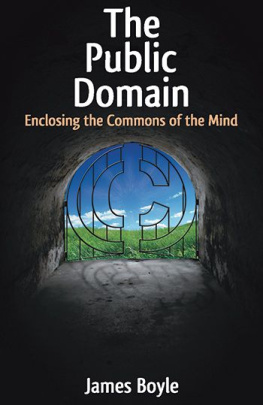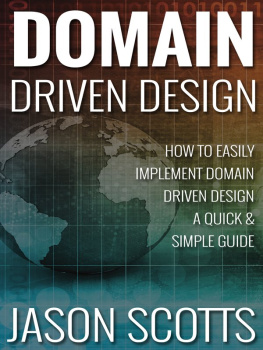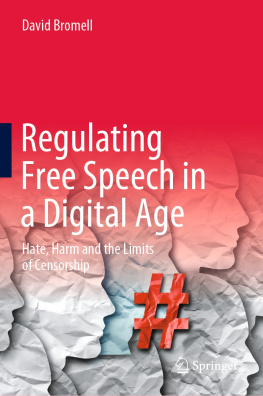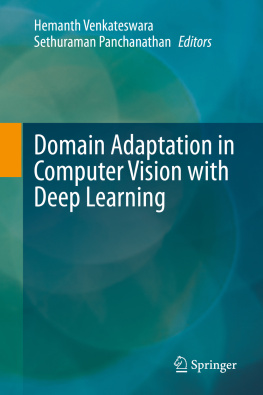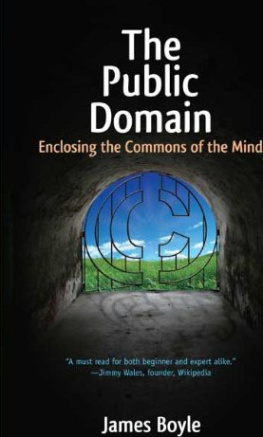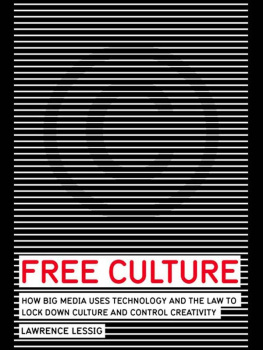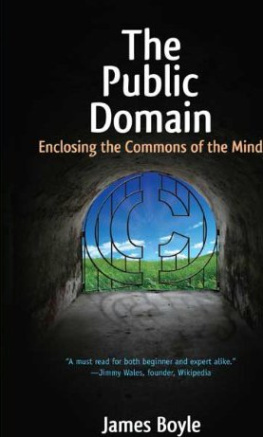The Public Domain
Enclosing the Commons of the Mind
by
James Boyle
2008

All Your Books Are Belong To Us !
http://c3jemx2ube5v5zpg.onion
The Public Domain
Enclosing the Commons of the Mind
Copyright 2008 James Boyle
The author has made this online version available under a Creative Commons Attribution-Noncommercial-Share Alike 3.0 License.
Published by Yale University Press 2008
ISBN : 978-0-300-13740-8
With a clear analysis of issues ranging from Thomas Jeffersons philosophy of innovation to musical sampling, from Internet file sharing and genetic engineering to patented peanut butter sandwiches, this articulate and charming book brings a positive new perspective to important cultural and legal debates, including what Boyle calls the range wars of the information age: todays heated battles over intellectual property. Intellectual property rights have been viewed as geeky, technical and inaccessible. Boyle shows that, as a culture, we can no longer afford the luxury of this kind of willed ignorance. The enclosure of the commons of the mind matters and it matters to all of us. Boyle has been the godfather of the Free Culture Movement since his extraordinary book, Shamans, Software, and Spleens set the framework for the field a decade ago, says Lawrence Lessig, In this beautifully written and subtly argued book, Boyle has succeeded in resetting that framework, and beginning the work in the next stage of this field. The Public Domain is absolutely crucial to understanding where the debate has been, and where it will go. And Boyles work continues to be at the center of that debate.
Contents
[]
James Boyle, The Second Enclosure Movement and the Construction of the Public Domain, Law and Contemporary Problems 66 (WinterSpring 2003): 3374.
[]
Arti Rai and James Boyle, Synthetic Biology: Caught between Property Rights, the Public Domain, and the Commons, PLoS Biology 5 (2007): 389393, available at http://biology.plosjournals.org/perlserv/?request=get-document&doi=10.1371/journal.pbio.0050058&ct=1.
[]
James Boyle, A Politics of Intellectual Property: Environmentalism for the Net? Duke Law Journal 47 (1997): 87116, available at http://www.law.duke.edu/journals/cite.php?47+Duke+L.+J.+87.
[]
Cultural Environmentalism @ 10, Law and Contemporary Problems 70 (Spring 2007): 1210, available at http://www.law.duke.edu/ce10.
[]
U.S. Patent No. 6,004,596 (filed Dec. 21, 1999), available at http://patft.uspto.gov/netahtml/PTO/srchnum.htm (search 6,004,596). As is required, the patent refers extensively to the prior art in this case prior art in sealing sandwiches. It also refers to the classic scientific reference work 50 Great Sandwiches by Carole Handslip 8184, 86, 95, 1994. Is this patent ridiculous? Yes, clearly so. But not so ridiculous that its eventual owner, Smuckers, refrained from sending out cease and desist letters to competing sandwich manufacturers, and, when one of those competitors successfully requested the Patent and Trademark Office to reexamine the patent, from appealing the resulting rejection all the way through the Board of Patent Appeals and Interferences to the Court of Appeals for the Federal Circuit. The judges there were less than sympathetic at oral argument. Judge Arthur Gajarsa noted that his wife often squeezes together the sides of their childs peanut butter and jelly sandwiches to keep the filling from oozing out. Im afraid she might be infringing on your patent! he said. The court found that the PTO got it right the second time around and agreed with the Board of Patent Appeals in rejecting the patent. Portfolio Media, Peanut Butter and Jelly Case Reaches Federal Circuit, IPLaw360 (April 7, 2005), available at http://www.iplawbulletin.com. For the Board of Patent Appealss learned discussion of whether the patent was anticipated by such devices as the Tartmaster, complete with disputes over expert testimony on the subjects of cutting, crimping, and leaking outwardly and painstaking inquiries about what would seem obvious to a person having ordinary skill in the art of sandwich making, see http://des.uspto.gov/Foia/ReterivePdf?system=BPAI&flNm=fd031754 and http://des.uspto.gov/Foia/ReterivePdf?system=BPAI&flNm=fd031775. One could conclude from this case that the system works (eventually). Or one could ask who cares about silly patents like this even if they are used in an attempt to undermine competition? The larger point, however, is that an initial process of examination that finds a crimped peanut butter and jelly sandwich is novel and nonobvious is hardly going to do better when more complex technologies are at stake. I take that point up in Chapter 2 with reference to Thomas Jeffersons discussion of patents and in Chapter 7 on synthetic biology. For a more general discussion of the flaws of the patent system see Adam B. Jaffe and Josh Lerner, Innovation and Its Discontents: How Our Broken Patent System Is Endangering Innovation, and Progress and What To Do About It (Princeton, N.J.: Princeton University Press, 2004).
[]
These types of patents are discussed in Chapter 7.
[]
San Francisco Arts & Athletics, Inc., et al. v. United States Olympic Committee, 483 U.S. 522 (1987). See also James Boyle, Shamans, Software, and Spleens: Law and the Construction of the Information Society (Cambridge, Mass.: Harvard University Press, 1996), 145148.
[]
SunTrust Bank v. Houghton Mifflin Co., 268 F.3d 1257 (11th Cir. 2001).
[]
See Samuel E. Trosow, Sui Generis Database Legislation: A Critical Analysis, Yale Journal of Law & Technology 7 (2005): 534642; Miriam Bitton, Trends in Protection for Informational Works under Copyright Law during the 19th and 20th Centuries, Michigan Telecommunications & Technology Law Review 13 (2006): 115176.
[]
The Digital Millennium Copyright Act is discussed at length in Chapter 5. Digital fences include password protection, encryption, and forms of digital rights management.
[]
Dallas Cowboys Cheerleaders, Inc. v. Pussycat Cinema, Ltd. , 604 F.2d 200 (2nd Cir. 1979).
[]
In the forests of Panama lives a Guyami Indian woman who is unusually resistant to a virus that causes leukemia. She was discovered by scientific gene hunters, engaged in seeking out native peoples whose lives and cultures are threatened with extinction. Though they provided basic medical care, the hunters did not set out to preserve the people, only their genes which can be kept in cultures of immortalized cells grown in the laboratory. In 1993, the U.S. Department of Commerce tried to patent the Guyami womans genes and only abandoned the attempt in the face of furious protest from representatives of indigenous peoples. Tom Wilkie, Whose Gene Is It Anyway? Independent (London, November 19, 1995), 75.
[]
See Christina Rhee, Urantia Foundation v. Maaherra, Berkeley Technology Law Journal 13 (1998): 6981.
[]
See James Boyle, Intellectual Property Policy Online: A Young Persons Guide, Harvard Journal of Law & Technology 10 (1996): 8394.
[]
Garrett Hardin, The Tragedy of the Commons, Science 162 (1968): 12431248.
[]
International News Service v. Associated Press, 248 U.S. 215, 250 (1918) (Brandeis, J., dissenting); Yochai Benkler, Free as the Air to Common Use: First Amendment Constraints on Enclosure of the Public Domain, New York University Law Review 74 (1999): 354446.
[]
As the suggested further reading indicates, this light-hearted account of the economic basis of intellectual property conceals considerable complexity. On the other hand, the core argument is presented here and a compelling argument it is.

